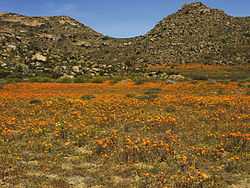Ephemeral plant
An ephemeral plant is one marked by short life cycles. The word ephemeral means transitory or quickly fading. In regard to plants, it refers to several distinct growth strategies. The first, spring ephemeral, refers to perennial plants that emerge quickly in the spring and die back to their underground parts after a short growth and reproduction phase. Desert ephemerals are plants which are adapted to take advantage of the short wet periods in arid climates. Mud-flat annuals take advantage of short periods of low water. In areas subjected to recurring human disturbance, such as plowing, weedy ephemerals are very short lived plants whose entire life cycle takes less than a growing season. In each case, the species has a life cycle timed to exploit a short period when resources are freely available.[1]
Spring ephemerals
Spring ephemeral describes a life habit of perennial woodland wildflowers which develop aerial parts (i.e. stems, leaves, and flowers) of the plant early each spring and then quickly bloom, and produce seed. The leaves often wither leaving only underground structures (i.e. roots, rhizomes, and bulbs) for the remainder of the year. This strategy is very common in herbaceous communities of deciduous forests as it allows small herbaceous plants to take advantage of the high levels of sunlight reaching the forest floor prior to formation of a canopy by woody plants. Examples include: spring beauties, trilliums, and harbinger of spring.[2]

Spring ephemerals include:
- Claytonia sp. (spring beauty)
- Dicentra canadensis (squirrel corn)
- Dicentra cucullaria (Dutchman's breeches)
- Dicentra eximia (turkey corn)
- Eranthis (winter aconite)
- Erigenia bulbosa (harbinger of spring)
- Erythronium americanum (yellow trout lily)
- Hepatica nobilis
- Houstonia caerulea (azure bluet)
- Iris cristata (dwarf crested iris)
- Jeffersonia diphylla (twinleaf)
- Lamprocapnos spectabilis (formerly Dicentra spectabilis, bleeding heart)
- Mertensia virginica (Virginia bluebells)
- Sanguinaria canadensis (bloodroot)
- Stylophorum diphyllum (celandine poppy, wood poppy)
- Thalictrum thalictroides (rue anemone)
- Tiarella cordifolia (foamflower)
- Trillium
Desert ephemerals

Desert ephemerals, such as the Arabidopsis thaliana, are plants which are adapted to take advantage of the very short favourable seasons in deserts. Annual plants in deserts may use the weedy ephemeral strategy to survive in the desert environment. These species survive the dry seasons through seed dormancy. Alternatively, some perennial desert plants may die back to their underground parts and become dormant when there is not enough water available.[3]
Mud flat ephemerals
Most water bodies have natural changes in water level over a year. For example, rivers have higher water periods after melting snow or rainy seasons, followed by natural low water periods. Large lakes have similar seasonal changes, but also changes over longer periods of time. Many short-lived plants, particularly annual plants, grow during low water periods, then set seeds which remain buried in the mud until the next low water period.[4]
Weedy ephemerals
Many agricultural weeds are ephemeral and reproduce rapidly after human disturbance from plowing. Roadside weeds similarly exploit the disturbance from road construction and mowing. These plants rarely have any commercial use, and can be invasive weeds. Examples include: Cardamine hirsuta and Cannabis ruderalis. Plants which have short life spans, rapid rates of growth, and high levels of seed production are also termed ruderals.[5]
References
- ↑ Keddy, P.A. 2007. Plants and Vegetation: Origins, Processes, Consequences. Cambridge University Press, Cambridge, UK. 666 p. Chapter 3, Resources.
- ↑ Archibold, O. W. 1995. Ecology of World Vegetation. London: Chapman and Hall.
- ↑ Archibold, O. W. 1995. Ecology of World Vegetation. London: Chapman and Hall.
- ↑ Keddy, P.A. 2000. Wetland Ecology: Principles and Conservation. Cambridge University Press, Cambridge, UK. 614 p. Chapter 2, Flooding.
- ↑ Grime, J. P. 1979. Plant Strategies and Vegetation Processes. Chichester: John Wiley.
| Look up ephemeral in Wiktionary, the free dictionary. |